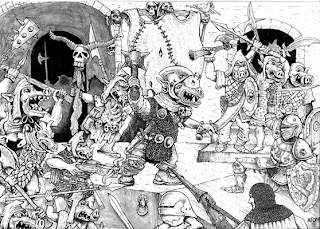SILLY ORCS

The creatures have been cannon fodder ever since they were first introduced to the game. Still, even after three decades there is an undeniable attraction to these foul humanoids, and rightfully so. Few other creatures can be used as liberally as the orc.
“You can chop ‘em, slice ‘em, dice ‘em…” The orc is the potato of the fantasy RPG. However, in over 20 years of gaming, I have yet to see these creatures assume any role other than that of the snarling pincushion. This creature is clearly suffering from bad P.R.
The real problem with using orcs in a game is that, well, they’re orcs. There aren’t many surprises here. Your players most certainly have preconceived notions about the race. Overcoming what your players already think about orcs is probably the most complicated aspect of using the creatures. Here are some things to think about when using orcs in your campaign.
Orcs are relatively cunning creatures. They live in a structured, if somewhat primitive society. They are capable of forging their own weapons and have a decided knack for making war. The orc is religious, having clerics and shamans, which indicates the race generally possesses a high enough wisdom to be able to explore concepts of divinity. Let us not forget they work out devious plans and execute them brutally. Yet the race always seems to get the short end of the stick.
Are orcs rocket scientists? Of course not. However, they make up for that deficiency with a lust for battle and primal ingenuity. The orc doesn’t need to be extremely smart in order to provide characters with a greater challenge. One way to do this is to create more advanced orc NPCs, creatures that have the experience, requisite cunning and skill to take command of their lesser brethren and lead them in an ordered fashion. Don’t be afraid to give them character levels to spice up their role in the game (and that CR).
These more threatening NPCs will use battle tactics against the players, instead of mindlessly attacking. They have a knack for survival, both physically and socially, after having worked their way up through the ranks of their tribe to assume a leadership role. The orcs likely have henchmen, and not the kind who admire their leaders for their nobility and battlefield morality either. These henchmen follow their orc leaders out of fear. They do terrible things to satisfy their battle lust, but they do know that their fate will be much worse if they should fail their leader.
You might even consider a less warlike approach to the orc. Perhaps a thieves’ guild composed of orcs would suit the needs of your campaign. You might wish to swap orcs’ key ability (Strength) out for Dexterity when creating orc thieves and assassins.
Another option includes religious orcs. Because of their primal nature, orcs are well suited to become shamans and druids. Higher wisdom scores are needed, making it prudent to adjust the NPCs statistics accordingly, possibly even taking a -2 Strength adjustment in favor of an equivalent bonus to Wisdom.
Any number of plotlines can be run involving a coven of orc druids/shamans. Perhaps this coven encroaches upon the territory of a benevolent druid order, and the PC’s are called to investigate. Perhaps the orcs are seeking their clan’s ancient ruins, containing hidden artifacts sacred to the coven and waiting for the druids to find them and harness their power once more.
The following NPCs are examples of orcs that have been given character levels and even templates to make them more interesting and challenging for PCs. Use and abuse these NPCs to your heart’s content.



Comments
Post a Comment